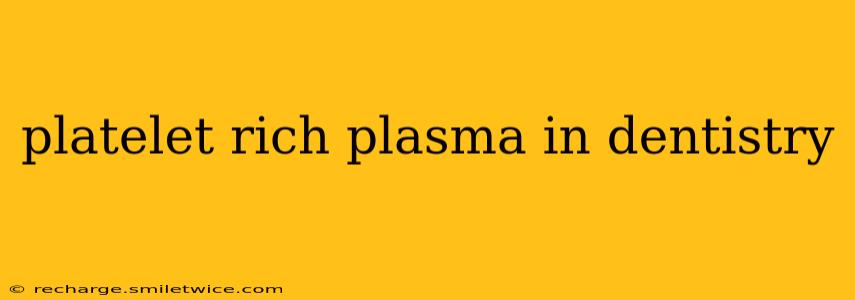Platelet-rich plasma (PRP) therapy is making waves in various medical fields, and dentistry is no exception. This innovative treatment harnesses the body's natural healing capabilities to promote faster recovery and improved outcomes for a range of dental procedures. PRP, derived from a patient's own blood, is rich in growth factors and proteins that stimulate cell regeneration and tissue repair. This article delves into the applications, benefits, and considerations of PRP in dentistry.
What is Platelet-Rich Plasma (PRP)?
Before we explore its dental applications, let's understand what PRP actually is. It's a concentrated solution of platelets, the blood cells responsible for clotting and initiating the healing process. Through a simple process involving blood collection and centrifugation, the platelets are separated and concentrated, creating a plasma rich in growth factors essential for tissue regeneration. Because it's derived from the patient's own blood, the risk of allergic reactions or rejection is minimal.
How is PRP Used in Dentistry?
PRP's regenerative properties make it a valuable tool in various dental procedures. Its applications include:
-
Socket Preservation: After tooth extraction, the empty socket can gradually shrink, leading to bone loss. PRP injected into the socket helps stimulate bone and tissue regeneration, preserving the alveolar ridge for future implant placement or preventing bone resorption.
-
Dental Implants: PRP can enhance the integration of dental implants into the jawbone, promoting faster osseointegration (the process by which the implant fuses with the bone). This can lead to improved implant stability and a shorter healing period.
-
Guided Bone Regeneration (GBR): In cases of significant bone loss, GBR techniques are used to reconstruct the jawbone. PRP significantly enhances the success rate of GBR by promoting bone growth and accelerating the healing process.
-
Soft Tissue Regeneration: PRP can stimulate the regeneration of soft tissues like gums, potentially improving gum recession and aesthetic outcomes.
-
Periodontal Treatment: In patients with periodontal disease (gum disease), PRP can help regenerate damaged tissues and reduce inflammation, improving the overall health of the gums and supporting structures.
What are the Benefits of PRP in Dentistry?
The use of PRP in dentistry offers several key advantages:
-
Faster Healing: The growth factors in PRP accelerate the healing process, leading to shorter recovery times after procedures like extractions or implant placement.
-
Reduced Inflammation: PRP helps reduce inflammation and swelling, minimizing post-operative discomfort.
-
Improved Aesthetic Outcomes: By promoting tissue regeneration, PRP can improve the aesthetic results of various dental procedures, such as gum grafting or implant placement.
-
Increased Success Rates: In procedures like implant placement or GBR, PRP can significantly increase the success rate by promoting better bone integration and tissue regeneration.
-
Minimally Invasive: The procedure for obtaining and using PRP is minimally invasive, causing minimal discomfort to the patient.
Does PRP Treatment Hurt?
The procedure to collect blood for PRP is similar to a routine blood test and is generally well-tolerated. While the injection of PRP may cause some mild discomfort, it's typically manageable and often described as a slight stinging sensation. Your dentist will likely use a numbing agent to minimize any discomfort.
How Long Does PRP Treatment Take?
The entire process, from blood collection to PRP preparation and injection, usually takes about 30-60 minutes, depending on the complexity of the procedure and the treatment area. The actual injection time is quite short.
How Much Does PRP Treatment Cost?
The cost of PRP treatment in dentistry can vary depending on several factors, including the specific procedure, the amount of PRP needed, and the dentist's fees. It's always best to consult with your dentist to get a personalized cost estimate.
Is PRP Treatment Right for Me?
PRP therapy is not suitable for every patient. Your dentist will assess your overall health, the specifics of your dental condition, and your treatment goals to determine if PRP is appropriate for you.
Conclusion
Platelet-rich plasma is a promising regenerative therapy offering significant benefits in various dental applications. Its ability to stimulate tissue regeneration and accelerate healing makes it a valuable addition to modern dentistry. However, it's crucial to consult with a qualified dentist experienced in using PRP to determine if it's the right treatment option for your specific needs. Remember, this information is for general knowledge and doesn't constitute medical advice. Always seek professional guidance from your dentist.
